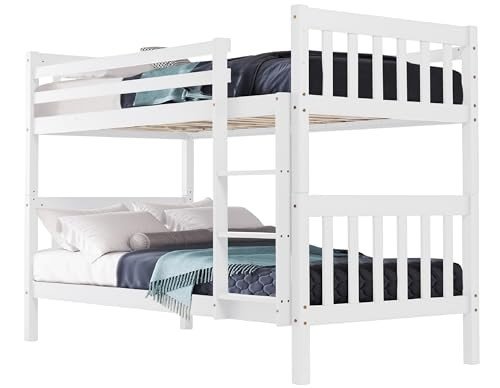Bunk Beds Sale: A Comprehensive Guide to Choosing the Right Bunk Bed for Your Home
Bunk beds have long been a staple in children's bedrooms, offering a mix of space-saving effectiveness and fun. Whether accommodating brother or sisters, friends on slumber parties, or simply taking full advantage of a playroom, bunk beds have actually become an essential aspect in modern-day household homes. As sales on bunk beds rise, it becomes progressively essential for consumers to make informed choices when purchasing one. This short article will cover the fundamentals of acquiring a bunk bed, from types to safety functions, in addition to tips for preserving the integrity of your investment.
Types of Bunk Beds
When thinking about a bunk bed sale, it's essential to comprehend the different designs offered on the marketplace. Below are the most typical types:
- Traditional Bunk Beds: These include 2 beds stacked one above the other, sharing a single frame. They are often the most cost-effective choice.
- L-Shaped Bunk Beds: This style includes one bed positioned vertically and another horizontally. This plan creates additional space underneath the upper bed, which can be used for storage or a backyard.
- Lofted Beds: Similar to traditional bunk beds but with no lower bed. Instead, the space beneath can be used for a desk, play location, or extra storage.
- Triple Bunk Beds: For households with a bigger number of children or frequent pajama parties, triple bunk beds offer three sleeping locations in a space-efficient design.
- Futon Bunk Beds: These styles combine bunk beds and futon couches. The bottom area converts into a different seating location, boosting performance.
- Convertible Bunk Beds: These beds can be separated into 2 private beds, making them versatile as kids's requirements change with time.
Table 1: Comparison of Bunk Bed Types
| Type | Description | Space Efficiency | Extra Features |
|---|---|---|---|
| Standard Bunk Bed | Two beds stacked vertically | High | Simplest style |
| L-Shaped Bunk Bed | One vertical and one horizontal bed | Moderate | Play or storage space |
| Lofted Bed | Raised bed with open space below | High | Work/play area |
| Triple Bunk Bed | Three stacked beds | Extremely High | Accommodates more users |
| Futon Bunk Bed | Bunk bed with a convertible futon | High | Multi-functional |
| Convertible Bunk Bed | Can be split into two separate beds | Moderate | Versatility & & durability |
Safety Features to Consider
Safety is paramount when investing in a bunk bed. Below are key security functions to look for:
- Guardrails: Adequate guardrails should exist on both sides of the upper bunk to prevent falls. Bunk Bed For Teens zacharywilshire.top ought to be at least 5 inches greater than the mattress.
- Ladder Design: Look for tough, large ladders with slip-resistant rungs. Guarantee that the angle is not too high for easy access.
- Stability: Ensure the bed is constructed with strong products, such as strong wood or heavy-duty metal. The bed ought to not wobble when in use.
- Weight Limit: Check the weight capacity of the bunk bed to ensure it can accommodate the desired users securely.
- Product Safety: If possible, choose beds made from non-toxic materials or those satisfying safety requirements for kids's furniture.
Table 2: Essential Safety Features
| Feature | Description | Importance |
|---|---|---|
| Guardrails | Sides of upper bed to avoid falls | Vital for child safety |
| Ladder Design | Strong, slip-resistant rungs | Aids safe and easy gain access to |
| Stability | Construct quality to prevent wobbling | Makes sure safety and durability |
| Weight Limit | Maximum weight capability | Prevents accidents |
| Product Safety | Non-toxic, safe products | Secures children's health |
Upkeep Tips for Bunk Beds
To extend the life of your bunk bed and ensure ongoing security, think about the following upkeep pointers:
- Regular Inspections: Periodically inspect the structure for loose screws, bolts, or any indications of wear. Tighten up fasteners as necessary.
- Clean Periodically: Dust and tidy the surface areas frequently. Usage appropriate cleaners that will not harm the finish.
- Examine Weight Limits: Be conscious of weight limits, especially with older children or adults who may want to use the upper bunk.
- Prevent Climbing on Guardrails: Educate kids not to use guardrails for climbing or playing to minimize the danger of mishaps.
Regularly Asked Questions (FAQs)
Q1: What is the age limitation for kids to safely use bunk beds?A: While it differs by the producer, many recommend that kids under six ought to not sleep in the upper bunk due to safety concerns.
Q2: How can parents prevent unsafe climbing?A: Setting clear rules about bunk bed usage and supervising children can help. Additionally, utilizing a bed tent can dissuade climbing up while developing a fun sleep environment.
Q3: What should I think about when decorating a room with bunk beds?A: Ensure there is enough space around the bunk bed for safe motion, and use the design to develop personalized spaces for each child.
Q4: Is a lofted bed suitable for older kids?A: Yes, lofted beds can be suitable for older kids as long as they satisfy safety requirements and the child is responsible enough to utilize them safely.
Bunk beds serve a functional purpose while adding a component of fun to a kid's bedroom. As sales of bunk beds continue to increase, mindful consideration of types, safety features, and maintenance practices is essential for parents and caregivers. By understanding these essential aspects, families can discover the ideal bunk bed for their home, making sure both functionality and security for years to come. Whether it's for brother or sisters sharing a room or developing a comfortable pajama party space, a well-chosen bunk bed can supply delight and functionality, making it a worthwhile financial investment.

